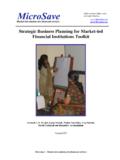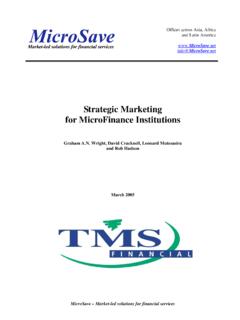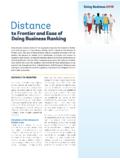Transcription of Process Mapping in Practice - MicroSave
1 MicroSave Market-led solutions for financial services Offices across Asia, Africa and Latin America Process Mapping in Practice Henry Sempangi, David Cracknell, Madhurantika Moulick and Hermann Messan March 2005 MicroSave Market-led solutions for financial services Acronyms used in this report DQA Domicile Quick Account Tanzania Postal Bank s savings product FINCA Foundation for International Community Assistance KPOSB Kenya Post Office Savings Bank MFI Microfinance Institution TPB Tanzania Postal Bank UMU Uganda Microfinance Union Please Provide Feedback to MicroSave This report summarises lessons learned from MicroSave s work with its Action Research Programme on Process Mapping .
2 However, MicroSave is conscious of the evolution of the microfinance industry worldwide. Many microfinance institutions are now aware of the need to continuously improve their processes and procedures in order to compete with the ever changing market environment. MicroSave would be very interested to learn more about other institutions application of the Process Mapping . We would like to obtain your feedback on the usefulness of the MicroSave range of studies and toolkits, so that they can be improved further. Feedback can be addressed to the MicroSave team on MicroSave Market-led solutions for financial services Process Mapping in Practice Henry Sempangi, David Cracknell, Madhurantika Moulick and Hermann Messan Introduction This paper summarises the experience that MicroSave has gained in Process Mapping through working with its Action Research Partners.
3 It highlights key benefits, which can be achieved through Process Mapping . It presents brief case studies detailing the experience of Tanzania Postal Bank and Equity Bank in Kenya. Finally it provides tips on how to overcome common challenges faced during the Process Mapping exercise. MicroSave s Experience: MicroSave has now worked with six of its eleven Action Research Partners and Action Research Associates to introduce Process Mapping and implement Process improvements. Two of the remaining institutions, Teba Bank and Credit Indemnity already use Process Mapping extensively.
4 In the final three institutions, Process Mapping has been used more selectively for new product development. Benefits and Costs: Positive results have been experienced from all institutions that have introduced Process Mapping . Process Mapping has had far greater strategic, management and operational impacts than suggested by simply reworking processes. Institutions have reported a significant number of quick wins. This may reflect the prior absence of a mechanism to review processes holistically. Costs of implementing Process Mapping have varied considerably, from the time taken to map individual processes to much larger teams and greater institutional involvement required in Mapping an institution.
5 Case studies: Two case studies are presented. Equity Bank reports improved risk management, standardised operations, improved training, enhancements in the banking system and customer service, but also notes the considerable challenges it has had to meet along the way. Process Mapping at Tanzania Postal Bank has brought fewer definable benefits, but Process Mapping was also a much shorter more focused exercise than at Equity Bank. Tips and Challenges: Using the experience of MicroSave in working through Process Mapping with its Action Research Partners, MicroSave has identified generic challenges at each stage of the Process .
6 It proposes strategies for managing these challenges. Many of the tips and challenges relate to ensuring that appropriate personnel are engaged at each step of the Process Mapping exercise, to ensure that sufficient skills and experience are reflected in the design of new processes. As with other institutional interventions, communication is a recurrent theme in maximising the potential of Process Mapping whether this relates to ensuring buy-in, Process redesign, or implementation of new processes. Institutionalising Process Mapping : Institutions that start by Process Mapping individual processes frequently end up Mapping much of their operations.
7 This is the greatest evidence that institutions value Process Mapping as a tool. In some cases the responsibility to update and maintain processes has been formally incorporated into job descriptions. One additional incentive for institutionalising Process Mapping is that it is a key component of international quality standards such as ISO 9001. MicroSave Market-led solutions for financial services BRIEF INTRODUCTION TO Process MAPPING1 As Is Process Mapping is a technique for making workflows visible. A Process map is a flowchart which shows who is doing what, with whom, when and for how long.
8 It shows how operational decisions are made and the sequence of events. Process maps are good for streamlining work activities and explain to new people, as well as internal and external customers, "what we do around here." They also can help in the effort to reduce cycle time, avoid rework, eliminate some inspections or quality control steps, and prevent errors. Process Mapping considers three states sequentially: maps show how processes are currently being performed. Should Be maps show prescribed procedures, usually in accordance with the organisations policies and procedures manuals. Could Be maps indicate how the procedures detailed in As Is and Should Be Maps can be redesigned to improve efficiency and reduce risks.
9 In each of the three states, MicroSave s approach considers four levels of analysis. Firstly, the map itself, secondly, a brief description of the Process , thirdly analysis of the risks involved in the Process and lastly potential controls to mitigate those risks. Properly used, Process maps bring a strategic approach to Process improvement and business management. MicroSave s Process Mapping exercises consist of ten key steps, which are outlined in the diagram overleaf. 1 Process Mapping is described in detail in A Toolkit for Process Mapping for MFIs Champagne et al, (2004).
10 CONCERNED PRIMARILY WITH SHOULD BE OR COULD BE STATES Choose Process to be mapped List out operational gaps Choose most important gap (s) Prioritize them Identify processes linked to these gap(s) Assemble an appropriate team Construct Map Gather Data - what - when - how - where Construct As Is Map, a descriptive map of Process Proofread Map Analyse Map Stage I What does the map say about Process ? Analyse Map Stage II Fine-tune Maps to reflect above with options of - Should Be Maps - Could Be Maps Brainstorming Stages II, Smaller Group - Is Process optimal? - Will uncovered risks still remain even if implementation is as it Should Be ?












